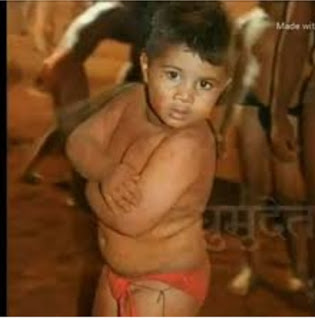kusti india's pride.
Creator: MUGHAL EMPIRE.
*Pehlwani is a form of wrestling from the Indian subcontinent. It was developed in the Mughal Empire by combining native malla-yuddha with influences from Persian varzesh-e bastani.[1][2] The words pehlwani and kushti derive from the Persian terms pahlavani and kosht respectively. It is likely that the word derives from the Irwanian word "Pehalavi" denoting to people of Iranian descent.
A practitioner of this sport is referred to as a pehlwan while teachers are known as ustad.[2] One of the most famous practitioners of pehlwani was The Great Gama (Ghulam Mohammad Baksh Butt), who is considered one of the greatest wrestlers of all time.
*Techniques
It has been said that most of the moves found in the wrestling forms of other countries are present in kushti, and some are unique to the Indian subcontinent. These are primarily locks, throws, pins, and submission holds. Unlike its ancient ancestor malla-yuddha, kushti does not permit strikes or kicks during a match. Among the most favoured maneuvres are the dhobi paat (shoulder throw) and the kasauta (strangle pin). Other moves include the baharli, dhak, machli gota and the multani.
*Other prominent Indian wrestlers
- Krishan Kumar Bhaprodia - Olympic participant, Bharat Kesari 1986, Rustam-e-Hind, 3 Times National Champion, 3 Times Army Service Champion, Jawahar Kesari[1][2][circular reference]
- Akram Pahalwan - son of the wrestling legend Imam Baksh Pahalwan
- Aslam Pahlwan - also trained by Mama Moti Singh
- Bholu Brothers - illustrious Pehlwan Brothers (Bholu, Aslam, Goga, Akram and Azam)
- Mehar din pahlwan - Rustam-e-Hind, a great wrestler openly challenged all so called top wrestlers of his time and openly double challenged Chandgi Ram and Dara Singh
- Mangla Rai - Rustam-e-Hind
- Goga Pahalwan - son of the wrestling legend Imam Baksh Pahalwan
- Great Gama
- Jaspal Singh Virk - wrestling Legend in India
- Gulam - accompanied the late Pandit Motilal Nehru to Paris in 1900 and defeated Cour-Derelli of Turkey
- Guru Hanuman - wrestler and coach
- Karim Bux - first wrestler to get into world headlines, when he defeated Tom Canon of England in 1892
- Kikkar Singh - Dev-e-Hind, known for his phenomenal chest and body
- Maruti Mane - Jakarta King 1962-1972
- Premnath Wrestler - Guru Premnath, Arjun Awardee 1972
- Rajkumar Baisla (Wrestler) - (Dhyan chand Awardee & Yash Bharti Award)
- Ramesh Kumar
- Uday Chand - Bronze Medalist World Wrestling championship
*Rules Kushti in Bharatpur
Wrestling competitions known as dangal or kushti, are held in villages and as such are variable and flexible. The arena is either a circular or square shape, measuring at least fourteen feet across. Rather than using modern mats, South Asian wrestlers train and compete on dirt floors. Before training, the floor is raked of any pebbles or stones. Buttermilk, oil, and red ochre are sprinkled to the ground, giving the dirt its red hue. Water is added every few days to keep it at the right consistency; soft enough to avoid injury but hard enough so as not to impede the wrestlers' movements. Every match is preceded by the wrestlers throwing a few handfuls of dirt from the floor on themselves and their opponent as a form of blessing. Despite the marked boundaries of the arena, competitors may go outside the ring during a match with no penalty. There are no rounds but the length of every bout is specified beforehand, usually about 25–30 minutes. If both competitors agree, the length of the match may be extended. Match extensions are typically around 10–15 minutes.[6] Unlike mat-based wrestling, there is no point scoring system; a win is achieved by pinning the opponent's shoulders and hips to the ground simultaneously, although victory by knockout, stoppage or submission is also possible. In some variations of the rules, only pinning the shoulders down is enough. Bouts are overseen by a referee inside the ring and a panel of two judges watching from the outside.
please like and mention your valuable comments in the comments box.




Well done &
ReplyDeletethankyou and please share.
DeleteOur pride
ReplyDeleteThank you please share
Deletethankyou for your valuable comment...
ReplyDeleteGreat information bro...
ReplyDeletethank u keep supporting and please share
DeleteGreat information
ReplyDeletethank u please keep supporting
DeleteNice
ReplyDeletethanks
DeleteNyc 👌🏻 👌🏻
ReplyDeletethank u keep supporting
Deletethanku keep supporting
DeleteNice
ReplyDeletethank u sir
DeleteKool
ReplyDeletethanks
DeleteGreat information sir
ReplyDeletethank u sir
DeleteNice info sir
ReplyDeletethanks sir
DeleteNice info. Bhai
ReplyDeletethank you
DeleteNici information
ReplyDeletethank u
ReplyDeleteKeep it up👍
ReplyDelete